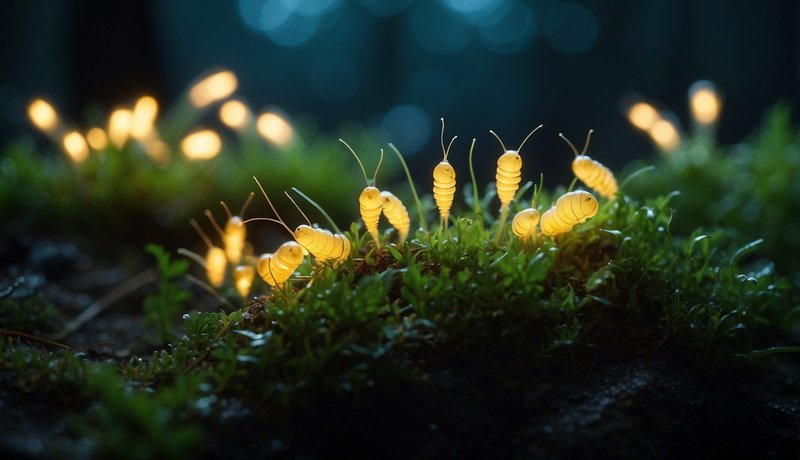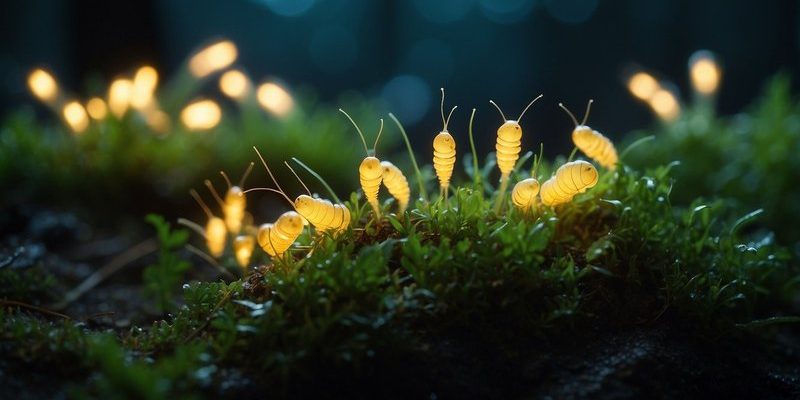
Glow worms, despite their name, are not actually worms; they’re the larval stage of certain beetles, particularly those of the Lampyridae and Lampyris families. They glow in the dark primarily to attract prey, but their role in the ecosystem goes beyond that. They are part of a complex web that connects soil, plants, insects, and larger animals, ensuring the health and stability of their surroundings.
So, why should we care about glow worms? Well, these glowing critters are like nature’s little helpers, aiding in processes that keep forests thriving. Let’s explore how they contribute to forest ecosystems, the challenges they face, and what we can do to help them shine brightly for years to come.
Understanding Glow Worm Biology
Glow worms can be found in dark, damp environments, typically in caves, forests, and along riverbanks. What makes them so special is their ability to produce light through a chemical reaction in their bodies. This glow comes from luciferin, a compound that reacts with oxygen to create bioluminescence.
Now, here’s the thing: not all glow worms are the same. In fact, there are over 2,000 species out there! The most famous is the Aglowis species, which can be found in various regions of New Zealand and Australia. These creatures spend most of their lives in the larval stage, often lasting up to a year. As larvae, they create silk threads to catch flying insects, which is their main food source.
In addition to their glow, glow worms have a unique life cycle. After about 8 to 12 months, they metamorphose into adult beetles, but adult glow worms don’t glow like their larval counterparts. Can you imagine having to give up your glow? For them, the adult stage is mainly focused on reproduction, which means they carry out their life mission without the charming light show.
The Role of Glow Worms in Food Webs
Glow worms are essential players in the forest food web. They serve as both predators and prey. As larvae, they catch and consume insects, including flies and moths, which helps regulate insect populations in their habitats. This makes glow worms important for maintaining a balanced ecosystem.
You might be wondering how a small creature can impact the entire forest. Well, think of it like this: when glow worms feast on insects, they help control pest populations. This is crucial, especially in forest ecosystems where overpopulation of certain insects can lead to damage to plants and trees.
On the flip side, glow worms are also food for various predators, including birds and larger insects. By being part of the food chain, they help support a variety of wildlife, including those beautiful birds you see flitting through the trees. This interconnectedness highlights their importance not just as individual species but as part of the larger ecological community.
Pollination and Plant Health
While glow worms are primarily seen as predators, their presence also indirectly supports plant health through pollination. Many of the insects they attract to their silk threads are pollinators. When these insects visit flowers for nectar, they help in the pollination process necessary for plants to reproduce.
Let’s break this down a bit further. When a glow worm catches a moth or fly, that insect might have visited nearby flowers before getting snared. By catching these insects, glow worms help remove them from the environment, but some of those insects may also carry pollen from plants. This means that glow worms play a supportive role in helping plants thrive.
Additionally, healthy plant life contributes to soil stability, preventing erosion and maintaining the overall health of forest ecosystems. Without glow worms, we could see a decrease in both insect diversity and plant reproduction, which would have a cascading effect on the forest environment.
Indicators of Environmental Health
Glow worms are excellent indicators of environmental health. Their presence often signifies a balanced ecosystem, while their decline could point to problems such as habitat destruction or pollution. Because they thrive in clean, moist environments, responsible scientists often monitor glow worm populations to gauge the overall health of forests.
When you think about it, they act like the canaries in the coal mine—if something goes wrong in the ecosystem, you can bet glow worms will be among the first to be affected. This highlights the importance of protecting their habitats. By ensuring that forests remain healthy, we not only help glow worms but also countless other species that rely on the same environment.
If you notice fewer glow worms during your nighttime hikes, it might be a sign that something’s off in the ecosystem. This could be due to climate change, pollution, or loss of habitat, which all threaten their existence.
Threats to Glow Worm Populations
Unfortunately, glow worms face several threats. One major issue is habitat loss, primarily due to deforestation and urban development. When forests are cut down or transformed into cities, glow worms lose their homes, and their populations can rapidly decline.
Another threat comes from light pollution. Since glow worms rely on their bioluminescence to attract prey, bright artificial lights can interfere with their hunting methods. When they are surrounded by competing lights, their glow can get lost in the shuffle, making it harder for them to catch food.
Climate change is also taking a toll on glow worms. Changes in temperature and humidity can affect their breeding cycles and food availability, leading to reduced populations. This combination of threats puts glow worms at risk, and by protecting them, we can help safeguard entire ecosystems.
How to Help Glow Worms Thrive
So, what can you do to support glow worms and their habitats? Here are a few actionable steps you can take:
- Protect natural habitats: Support conservation efforts and organizations that protect forests and natural areas.
- Reduce light pollution: If you live near glow worm habitats, be mindful of outdoor lighting. Using motion sensors or dimmer lights can help keep areas darker.
- Educate others: Share your knowledge about glow worms and their importance with friends and family. Raising awareness can inspire more people to protect these fascinating creatures.
- Participate in local cleanups: Keeping forests clean helps ensure that glow worms and other wildlife have safe environments to thrive in.
By actively supporting glow worm populations, you contribute to a healthier forest ecosystem, ensuring that this magical display of light continues for generations to come.
Glow worms may be small, but their impact on forest ecosystems is anything but insignificant. From regulating insect populations to supporting plant health and serving as indicators of environmental quality, they play integral roles that can easily be overlooked.
Next time you’re wandering through a forest and spot those dazzling lights, take a moment to appreciate the essential work glow worms do. They remind us of the delicate balance within nature’s web, where every creature, no matter how small, plays a part in maintaining a thriving environment. By understanding and protecting these glowing guardians, we can help ensure that our forests remain vibrant and filled with life for years to come.

